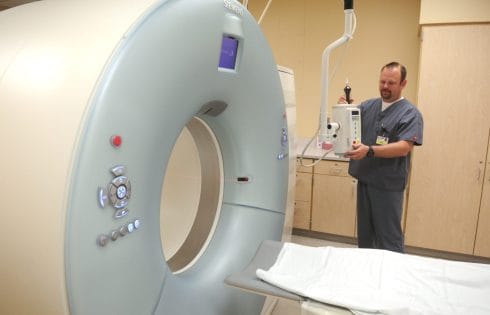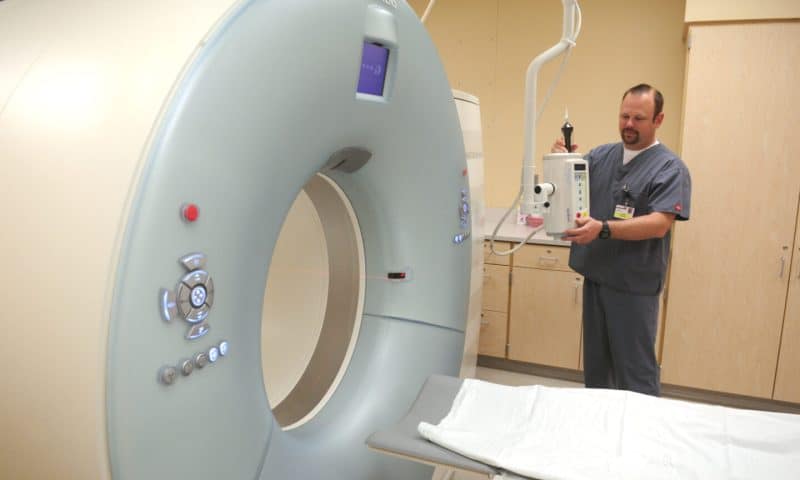
Computed tomography scans have become vital, even lifesaving, medical imaging for diagnosing and monitoring health conditions. But they do expose patients to ionizing radiation at levels linked to higher risks of cancer. In a new study in JAMA Internal Medicine, researchers tried to estimate what those higher risks are exactly—and although the estimates come with uncertainty, they may seem startling.
Based on data from 93 million CT scans performed on 62 million people in 2023, the researchers estimated that the CT scans would lead to 103,000 future cancers. To put that in context, those 103,000 cancers would account for about 5 percent of cancers diagnosed each year, based on the current cancer rates and the current usage of CT scans. And the estimate puts CT scans on par with alcohol consumption and obesity in terms of risk factors for developing cancer.
The most common types of cancers estimated to be a result of CT scans were lung cancer and colon cancer—two cancers that are becoming more common in younger people for reasons experts do not fully understand. The types of CT scans linked to the greatest number of cancers were abdomen and pelvis CT scans.
The study’s authors—led by epidemiology and biostatistics researchers at the University of California, San Francisco—concluded that doctors should use CT scans when they can be justified and at optimized doses to balance the risks and benefits.
“CT is frequently lifesaving, yet its potential harms are often overlooked, and even very small cancer risks will lead to a significant number of future cancers given the tremendous volume of CT use in the United States,” they write. Since 2007, use of CT scans has increased 35 percent, an increase not entirely explained by population growth, they note
Outside experts agreed that CT scans should be used judiciously. But, they highlighted that there is much uncertainty in the modeling, which tried to assess absorbed doses in different organs and the increased risk of site-specific cancer. While some large studies have found links between CT scans in children and young adults and increased risks of blood and brain cancers, the risks for adults have largely been extrapolated from studies on Japanese atomic bomb survivors or people with occupational radiation exposures.
Uncertainty and balancing
“The estimates, while based on the best models available to the authors, are indirect, so there is considerable uncertainty about the estimates,” Stephen Duffy, emeritus professor of Cancer Screening at Queen Mary University of London, said in a statement. “Thus, I would say to patients that if you are recommended to have a CT scan, it would be wise to do so.”
Duffy also highlighted that in the context of a person’s overall risk of cancer, CT scans don’t move the needle much. There were a little over 100,000 cancers linked to 93 million scans. “This amounts to around a 0.1 percent increase in cancer risk over the patient’s lifetime per CT examination,” he said. The lifetime risk of cancer in the US population is around 40 percent. Thus, the additional risk from CT scans “is small.” Overall, when a CT scan is deemed necessary, the “likely benefit in diagnosis and subsequent treatment of disease outweighs the very small increase in cancer risk.”
Doreen Lau, a cancer biology expert at Brunel University of London, agreed: “The findings don’t mean that people should avoid CT scans when recommended by a doctor. In most cases, the benefit of detecting or ruling out serious illness far outweighs the very small risk of harm.”
Still, the rise in CT scans in recent years may suggest that doctors could cut back on their use. In an accompanying editorial, Ilana Richman of Yale University and Mitchell Katz of NYC Health and Hospitals discussed ways that doctors could make sure they’re balancing risks and benefits before using CT scans, including using diagnostic algorithms and offering alternative imaging options, such as ultrasounds and magnetic resonance imaging (MRIs).
“As with all complex problems, there will be no simple solution,” they write. But, “educating clinicians about avoiding low-value testing and, in circumstances where alternatives are readily available, involving patients in the decision to do a CT scan may help shift culture and practice.”

